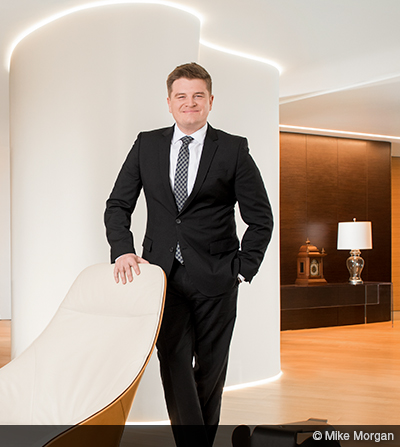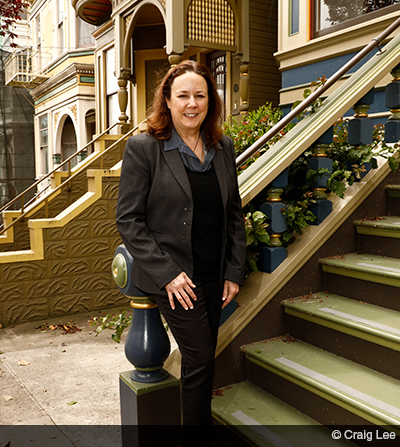The Modernist
When you think of sleek, modern homes, the traditionalist Washington, D.C., area is not the first place that typically comes to mind. Colonials and Greek revivalism seem to populate every other block, which gives Ron Mangas Jr.’s focus on contemporary homes a kind of rarefied status. Mangas’s four-person team, The Contemporary Listings Group at TTR Sotheby’s International Realty in McLean, Va., closed nearly $39 million in total dollar volume in 2017; 87 percent of the 15 listings they sold were modern, and 77 percent of the 21 buyers they assisted bought modern properties. Mangas usually refers deals that stray outside the modern style to one of the two other associates on his team. But all their marketing dollars go toward attracting buyers and sellers who are interested in this niche.

Early on, Mangas saw an opportunity to engage with the wider modern architecture community by featuring other professionals prominently in his listing marketing. He features the architects who designed his listings and makes sure to always display photo credits for photographers, whose work elegantly captures the beauty of modern architecture. “I try to support the whole team that helped put such a unique product on the market. And that helps support me in the long run.” Mangas also helps connect consumers with this professional community. Every year, he puts together a modern home tour, generally featuring contemporary homes that are not on the market. He invites the architect and others involved in the home’s story to the events, which helps draw significant crowds. Though these tours cost $40 to $60 to attend, Mangas says he’ll get 300 to 500 visitors in a day.
Technological limitations at the MLS level also presented an opportunity. While colonials can be classified in multiple ways in his local MLS, there’s no “modern architecture” category, which makes it harder to find the style in property searches. “The only thing that touches our niche is ‘contemporary,’ ” he says of the MLS categories. “That’s the reason for my URL, contemporarylistings.com. I wanted to create a listing service for the area’s best contemporary homes [because] it’s hard for buyers to sort through.”
Mangas loves his job, but in the very next breath likens the niche to “shooting myself in the foot.” Many contemporary homes were custom-built in close consultation with the future owners and don’t follow cookie-cutter rules about where rooms should be located. “When you put it on the resale market, it can be difficult,” he says. “The best buyer in the market is the homeowner themselves.” Though he says his niche is “the hardest inventory to sell in the region,” Mangas wouldn’t have it any other way. “It’s driven so much by love. I get to be joyful about every listing.”
The Historian
Sometimes the neighborhood chooses your niche for you. Bonnie Spindler, CRS, team leader at Zephyr Real Estate in San Francisco, didn’t start out as a specialist in Victorian homes. But as a history buff and former antiques dealer, she loved buying old houses and fixing them up. So when she moved her real estate business from Minnesota to San Francisco in the 1990s, she was immediately drawn to Alamo Square, with its famous, much-photographed “Painted Ladies”—Victorian and Edwardian houses whose exteriors were painted in three or more colors in the 1960s in order to enhance their architectural details.

While Victorian-style homes (generally any house built during the reign of Queen Victoria, between 1837 and 1901) are equated more with romance than practicality, Spindler says they confer several structural advantages. Their old-growth redwood is less vulnerable to pests and earthquakes than newer homes’ framing. But there are also drawbacks. Victorians were almost always built without electrical service, so sometimes original gas pipes haven’t been turned off or may have residual gas in their lines after they’ve been capped. This can be an issue for workers who might be cutting into old lines. And while many love the feeling of 11-foot ceilings, it’ll take more steps to get to the next floor, and painting and changing lightbulbs can be more involved. But (especially since many of the architectural plans for these homes were destroyed in the San Francisco earthquake of 1906) being aware and offering insights to clients about such positives and negatives are just part of the job of a style specialist, and Spindler embraces her role as adviser. “None of them come with manuals,” Spindler says. “It’s an exploratory process.”
Spindler is active in local preservationist and historic groups. But perhaps the most important connection she can make is with a capable contractor. While the exteriors of many San Francisco Victorians are protected by historic preservation ordinances, the interiors are generally not. Electricians and plumbers often suggest that the only way to update a Victorian is to tear out original walls. But Spindler knows it can be less expensive to drop pipes and other infrastructure straight through the home’s balloon framing or to wire electrical lines through an attic than to tear out valuable, original plaster work. “The crazy things that people do to these poor old houses. The walls never look the same,” Spindler laments. She compares the work of contractors who skillfully retain old Victorian walls to that of arthroscopic surgeons, who use fiber optic technology and video cameras to avoid open surgery: “It’s better for the patient in the long run.”
While Spindler is glad to see more young people interested in historic homes, she acknowledges her niche is limited by the number of Victorians in her market, estimated to be around 7,500 single-family homes. “It’s not a lot, and we lose more every year,” she says. “They’re not making any more of them, obviously.”
Not a “Mad Man”
William Bedgood has a theory about why midcentury modern styles have come back into fashion with such force, and it’s not because of the mania around TV’s “Mad Men.” He started noticing the motif popping up in national ad campaigns around a decade ago—the design aesthetic was being used to sell everything from cars to window cleaning solution. For him, it simply comes back to demographics. “People who grew up in the ’50s; they’re in a position to—and they want to—relive their childhood,” he says. But it’s not just boomers; Bedgood, team leader of Bedgood & Associates Real Estate Group at Keller Williams Intown in Atlanta, notes that millennials are some of the most ardent appreciators of midcentury modern style. He suggests that younger consumers may instead be reacting against the styles that dominated in the 1990s. “The 10,000-square-foot mansion wasn’t cool anymore. Instead of the bigger house, they wanted a better house.”

Bedgood spent his first half-dozen years as a real estate professional in Savannah, Ga., where he began cultivating the niche. He would canvass local neighborhoods and snap photos of midcentury modern homes, researching tax records and adding pertinent information to his database. He’d also personally reach out to homeowners, either by knocking on doors or sending a handwritten note. The intention was less about future sales and geared more toward simply introducing himself and expressing admiration for the condition and style of the home, something homeowners seemed to appreciate. “A lot of it was just approaching them and saying, ‘Hey, I live in a midcentury house too. I saw your house; it’s amazing. I love it,’ ” he says. “They want to talk about that. They want to share.”
When Bedgood moved his business to Atlanta, he took it up a notch. He added Facebook and Instagram pages to his Savannah-born outreach strategy. Rather than being a place for Bedgood to post listings, these social pages allow fans to share photos of local examples of the architectural style and discuss plans for updating their own midcentury homes. “I really didn’t begin it as a business opportunity,” Bedgood says. “I thought of it as a community, an opportunity to put people together.” Eventually he brought this collection of like-minded individuals together in the real world. Bedgood now organizes events, often in the form of a cocktail party at the midcentury home of one of the online communities’ participants, once every quarter. He estimates that about 20 percent of the 50 transactions representing $15 million in sales that the team closed in 2017 were for midcentury modern properties. Succeeding as a style expert, he says, ultimately has less to do with the type of home style you choose than with your own zeal: “It needs to be a passion. I don’t know that it would really work otherwise. You could do it, but it would be work—not fun.”




